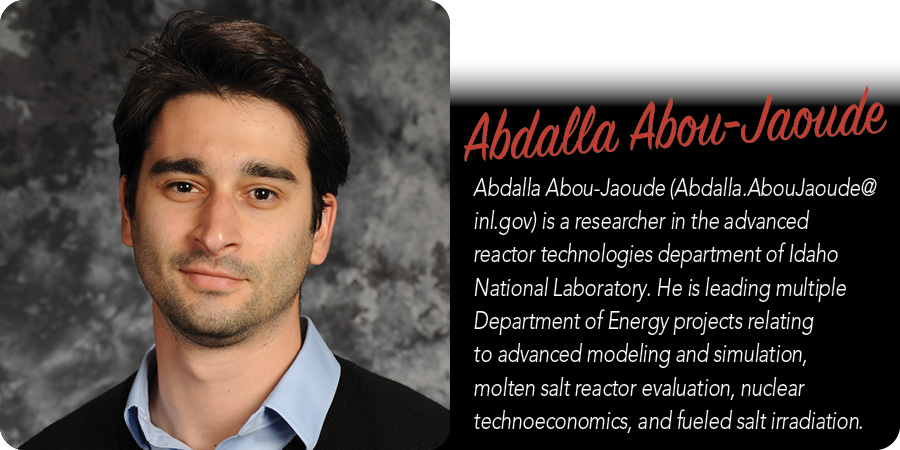A pair of NRC workshops coming up

The Nuclear Regulatory Commission’s Office of Nuclear Regulatory Research is hosting two workshops on reactor topics before the end of the year.


The Nuclear Regulatory Commission’s Office of Nuclear Regulatory Research is hosting two workshops on reactor topics before the end of the year.

It’s been almost 35 years since Illinois last added a nuclear power reactor to the grid (Braidwood-2, a pressurized water reactor operated by Constellation, reached commercial operation in October 1988). And it’s been 63 years since a research reactor reached initial criticality at the University of Illinois–Urbana-Champaign (UIUC). The university’s TRIGA Mark II started up in August 1960 and was shut down in 1998. For about 25 years, UIUC—the flagship public university in a state that generates more power from nuclear energy than any other—has lacked an operating research reactor.
Probabilistic risk assessment is a mature technology that has benefited the safety of the current fleet of light water reactors in the United States since the 1970s. Most utilities have used PRA models as part of risk-informed in-service inspection programs to identify degraded plant conditions for more than two decades. The trends indicate an increasing use of risk-informed applications to support safe and cost-effective long-term operations.
Data science and predictive analytics innovations offer the opportunity to assess, monitor, and manage risk effectively. PRA models are coupled with digital twins informed by sensors and system simulators that provide real-time risk insights. Dynamic PRA approaches were initially introduced to beyond-design-basis event models for LWRs and explicitly model time-dependent operator behavior by simulating the actual plant response. Enhancing the quantification speed and memory usage of the PRA computational tools (both dynamic and traditional) is crucial for future risk-informed efforts.

Barnard

Donalds
“To be frank, any emissions-related climate goals are moonshots without nuclear energy, and next-generation nuclear technology is something that the United States can and SHOULD lead on.” So writes U.S. Rep. Byron Donalds (R., Fla.) and Christopher Barnard, vice president of external affairs for the American Conservation Coalition, in an essay published by RealClear Energy.
Good news: Donalds, one of the strongest advocates for nuclear energy in the U.S. House, and Barnard, publisher and coauthor of Green Market Revolution, begin their essay by noting some recent positive developments for nuclear power. They characterize the initial criticality of Vogtle-3, the first new nuclear reactor built in the United States in about 30 years, as “a monumental achievement for the American nuclear industry.” They praise the Biden administration’s allocation of funds to keep established nuclear plants operational.

Further building on their already secure reputations as nuclear energy supporters, Sens. Joe Manchin (D., W.Va.) and Jim Risch (R., Idaho) yesterday reintroduced the International Nuclear Energy Act (INEA). (The lawmakers are also cosponsors of two recently debuted nuclear-themed bills: February’s Nuclear Fuel Security Act and last week’s Reduce Russian Uranium Imports Act.)

Donalds
Rep. Byron Donalds (R., Fla.) recently introduced in the House a four-bill nuclear energy package that, according to the congressman’s office, seeks to “reshape the way our country uses and views nuclear energy.”
Included in the package are the following measures—all originally introduced in the 117th Congress:
The use of small modular reactors would be an excellent, cost-effective way to recharge electric heavy-duty vehicles (HDVs), such as trucks, according to a recent study published in Applied Energy. The Idaho National Laboratory–funded study was conducted by researchers at the University of Michigan.
The Post-Industrial Midwest and Appalachia (PIMA) Nuclear Alliance hosted its third workshop December 8—9 at Pennsylvania State University’s Digital Foundry at New Kensington. The alliance, which consists of Penn State and several academic, industrial, and national lab partners, was formed in May 2022 to harness carbon-free energy while educating and training the future energy workforce. Previous workshops were held in June and October this year.
Microreactor technology: The major focus of the alliance is innovation in microreactor technology and other advanced nuclear reactor technologies in the Midwest and Appalachia regions, with the overall goal of furthering the decarbonization of industries.
A bipartisan group of senators sent a letter last week to Scott Nathan, chief executive officer of the U.S. International Development Finance Corporation (DFC), urging the agency to begin financing nuclear energy projects and support the continued development and deployment of advanced nuclear technology.
Signing the December 8 letter were Sens. John Barrasso (R., Wyo.), Cory Booker (D., N.J.), Shelley Moore Capito (R., W.Va.), Ben Cardin (D., Md.), Chris Coons (D., Del.), Kevin Cramer (R., N.D.), Joe Manchin (D., W.Va.), Lisa Murkowski (R., Alaska), and Jim Risch (R., Idaho).

Donalds
“I wholeheartedly believe that utilizing nuclear energy—specifically advanced nuclear microreactors—could have made a positive difference for Florida’s 19th District in many ways,” wrote Rep. Byron Donalds (R., Fla.) in an op-ed about Hurricane Ian that appeared in the Floridian on December 5. Donalds noted that Ian, which struck southwest Florida (the location of his congressional district) on September 28, 2022, was an “unforgettable storm” that caused “heart-wrenching devastation” to the area but that “the deployment of microreactors throughout Southwest Florida could have: (1) reduced disaster-related mortality; (2) reduced direct disaster-related economic loss; and (3) reduced the overall disruption of basic services stemming from Hurricane Ian’s devastation.”
Microreactor technology and benefits: Donalds offered his readers a brief lesson on nuclear microreactors, explaining that they are “small, versatile, and extremely reliable pieces of innovative technology” that put to rest common public concerns about nuclear energy related to “large smokestacks, nuclear waste, and nuclear meltdowns.”

The Department of the Air Force and the Defense Logistics Agency–Energy have released a request for proposals (RFP) for the construction and operation of a microreactor in central Alaska. The Department of Defense wants a 20-year supply of electricity and steam from a 1–5-MW microreactor, but the Eielson Air Force Base (AFB) Microreactor Pilot Program will go beyond a simple power purchase agreement and put the reactor through its paces with tests, at least annually, of the reactor’s walk-away safety and black-start capabilities. The final RFP is available at sam.gov.

Representatives of Ultra Safe Nuclear Corporation (USNC) of Seattle, Wash., and Hyundai Engineering of Seoul, South Korea, traveled last week between USNC project sites in Oak Ridge, Tenn., and Ontario, Canada, to sign two agreements extending their collaboration on the deployment of USNC’s high-temperature, gas-cooled Micro Modular Reactor (MMR). The agreements expand on a business cooperation agreement signed in January 2022 and an engineering agreement signed in June, and follow the closure earlier this month of a previously announced $30 million equity investment after its review by the U.S. Treasury Department’s Committee on Foreign Investment in the United States.

The Electric Power Research Institute (EPRI) has launched the Nuclear in District Energy Applications (NuIdea) Initiative to support the use of nuclear power in district energy systems. The new program, which is part of the EPRI’s Nuclear Beyond Electricity Initiative, has the goal of promoting microreactors (up to 10 MW) for heating, cooling, and power applications in institutional settings by 2026.

ANS’s August 4 online event “The New Space Race is Going Nuclear” featured several expert panelists who discussed the growing importance of nuclear technologies in space commercialization and exploration. Although nuclear energy has long played a role in space missions, participants discussed the latest exciting developments in the space nuclear field and presented their views on how increased application of nuclear technologies could fundamentally transform the ways in which both crewed and uncrewed space missions are carried out.
The Nuclear Regulatory Commission recently approved, in a 2–1 vote, a recommendation from its staff that could potentially lead to the siting of advanced reactors in more densely populated areas than is permitted for traditional light water units.
NRC chairman Christopher Hanson and David Wright voted in favor of the recommendation, with Jeffery Baran casting the lone “nay” vote. (There are currently two open seats on the five-member commission.)

The Nuclear Innovation Alliance (NIA), a Washington, D.C.–based nonprofit, has released a new report, Advanced Nuclear Reactor Technology: A Company Compendium, along with an update to its Advanced Nuclear Reactor Technology: A Primer, first published last September.
Both reports are meant to serve as resources for investors, reporters, policymakers, regulators, and others wanting to learn more about the different technologies and key players involved in the design, licensing, construction, and operation of advanced nuclear reactors.

Microreactors upend the traditional economics of nuclear power plants by shifting the paradigm from economies of scale (large reactors) to economies of multiple (mass production). While shrinking power output per unit may increase costs per kilowatt compared to large plants, offsetting gains can be expected from simplified and standardized designs, factory fabrication, inherent safety, lower radionuclide inventories, fast installation, and low financing costs. For instance, the lower power density in a microreactor core leads to a greatly reduced decay heat source, simplifying emergency cooling needs. These design aspects can lead to innovations including substantial simplifications to safety and control needs, minimized human operational requirements, a very compact balance of plant, the ability to fabricate almost every component in a factory, shortened construction time, and less daunting financing.

From refugee in Bangladesh to top nuclear engineer at Idaho National Laboratory, ANS member Yasir Arafat has led quite an interesting life, as described in a recent online profile written by Donna Kemp Spangler for the INL website. Arafat is leading the development of the Department of Energy’s Microreactor Applications Research Validation and EvaLuation (MARVEL) project at INL. The profile notes that MARVEL, which Arafat envisioned soon after joining INL in 2019, is scheduled to be “built and demonstrated at INL’s Transient Reactor Test Facility and connected to the world’s first nuclear microgrid within two years.”

An article posted on the Interesting Engineering website on March 10 highlights a recent YouTube video that provides an overview of the advantages, current status, future possibilities, and practical challenges of small modular reactors, along with a look at the even smaller microreactors. The video is available on the “Undecided with Matt Ferrell” channel. Ferrell describes himself as “a UI/UX [user interface/user experience] designer by trade” and “a lifelong tech enthusiast.”

A full-scale, electrically heated prototype for the Department of Energy’s Microreactor Applications Research Validation and Evaluation (MARVEL) project was fabricated in just nine months, according to an article published by Idaho National Laboratory on January 31. The article explains in part how a team from the lab’s machine shop created the prototype.